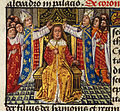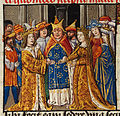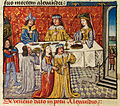Folio 1r.: School, with Cato and his translator (seated below) instructing pupils.
Folio 2r.: Translator addressing his master on a road leading from a castle to a farm.
Folio 8v.: Translator addressing his master, with a man ploughing in the background.
Folio 14v.: Translator addressing his master, indoors.
Folio 19r.: Translator addressing his master, in a garden.
Folio 29v.: (i) Nectanebus enthroned, receiving news of Artaxerxes’ threatened invasion; (ii) Nectanebus in his chamber bewitching Artaxerxes’ fleet in a basin of water.
Folio 30r.: Translator addressing his master.
Folio 34r.: Alexander killing Nectanebus, his father, by throwing him into a ditch.
Folio 34v.: Bucephalus being presented to Philip; Bucephalus in a cage with the remains of condemned criminals, being tamed by Alexander.
Folio 37v.: Alexander, mounted on Bucephalus, entering Italy with his followers.
Folio 44r: Alexander outside the gates of Abdyra receiving the keys of the city.
Folio 51v.: Alexander’s first victory over Darius, the Persian king.
Folio 56v.: Alexander’s third victory over Darius; Darius escaping over the river in a cart.
Folio 59r: The murder of Darius by his own generals; Alexander at the side of the dying king.
Folio 60v.: The coronation of Alexander.
Folio 61r.: Alexander has the murderers of Darius executed by hanging.
Folio 61v.: The marriage of Alexander and Darius’ daughter.
Folio 64r.: Alexander’s first victory over Porus.
Folio 66v.: Alexander’s meeting with Talistris, Queen of the Amazons.
Folio 67r.: Alexander, his men and beasts suffering from thirst by a river.
Folio 68v.: Alexander and his men facing amazing beasts across a river.
Folio 70r.: Alexander killing Porus in single combat before their armies.
Folio 72v.: Alexander’s tents on fire, and amphibious men and women standing in water.
Folio 73v.: Alexander sending a message over a river to the Brahmins.
Folio 82r.: The battle with woodland men armed with clubs.
Folio 83r.: Alexander climbing up to the palace on the Adamantine mountain.
Folio 84v.: Alexander and his companions consult the prophetic
trees of the Sun and the Moon; Alexander meeting a black-legged monster man, a horse-lion and headless men.
Folio 90r.: Alexander fighting a crowned dragon; long-haired women emerging from a river.
Folio 92r.: Alexander fighting the dog-headed Cynocephali.
Folio 94v.: Alexander and his queen at table, and again in the foreground with a feather in his throat after being poisoned.
Folio 95v.: Alexander on his deathbed, surrounded by mourners, and dictating his will to his notary.































